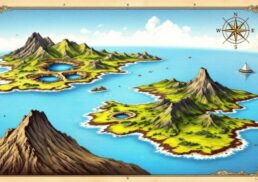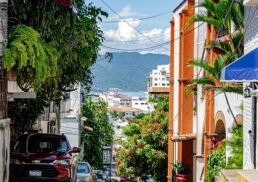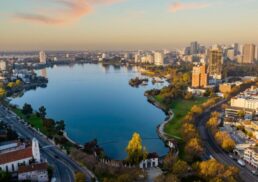Canada Nova Scotia, an Atlantic province laden with history, culture, and striking landscapes, offers a blend of experiences for the eager explorer. This article serves as your guide, eloquently unraveling Nova Scotia’s allure. From the vibrant city life in Halifax to the wild cliffs of Cape Breton and the economic heartbeat driving its growth, prepare to delve into the core of what makes Nova Scotia quintessentially Canadian yet distinctly its own.
Table of Contents
Key Takeaways
Halifax is the capital of Nova Scotia, serving as a center for governance, culture, and history, with a rich arts scene and institutions like the Nova Scotia College of Art and Design University and the Art Gallery of Nova Scotia.
Cape Breton Island is a natural and cultural treasure featuring the scenic Cabot Trail, varied landscape, and rich Gaelic and Acadian heritage that drive tourism and cultural preservation.
Nova Scotia’s economy is diverse and dynamic, with major sectors including fishing, seafood export, education, and tourism, contributing significantly to the province’s GDP and job market.
Exploring the Heart of Nova Scotia: Halifax

Halifax, officially known as the Halifax Regional Municipality, stands as the beating heart of Nova Scotia. This vibrant city, home to over 45% of the province’s population, is a compelling blend of history, culture, and modernity. Established by Edward Cornwallis on June 21, 1749, Halifax has since played a pivotal role in the region’s history, serving as both the provincial capital and a significant cultural hub near the Halifax Harbour.
The city’s cultural landscape is rich with institutions such as:
Nova Scotia College of Art and Design University
Art Gallery of Nova Scotia
Neptune Theatre
Dalhousie Arts Centre
All of which contribute to a thriving arts scene. Halifax is a magnet for tourists and locals alike, attracting attention with its array of museums, world-class musicians, cultural festivals, and historical sites.
In the following subsections, we will:
Dive deeper into Halifax’s role as the provincial capital
Explore its connectivity through the Halifax International Airport
Feel the cultural pulse that beats within this dynamic city.
Halifax’s Role as Provincial Capital
Halifax serves as the provincial capital of Nova Scotia, a Canadian province, embodying the province’s governance under a parliamentary system within the framework of a constitutional monarchy. Premier Tim Houston leads the province, and members of the Legislative Assembly are elected through single-member plurality in each of the province’s 51 electoral districts or ridings.
This governance structure ensures that Halifax not only functions as the administrative heart of Nova Scotia but also as a vibrant urban center where political, economic, and cultural activities converge. The city’s role as the capital is integral to its identity, shaping its development and influence within the province and beyond.
Halifax International Airport and Connectivity
Halifax International Airport serves as a crucial gateway to Nova Scotia, connecting the province to major cities across the world. For visa-exempt foreign nationals traveling to Canada by air, obtaining an Electronic Travel Authorization (eTA) is essential before boarding their flight. The airport also facilitates smoother travel for frequent flyers to the United States through the NEXUS program.
Travelers can find specific requirements for connections to the United States on the airport’s U.S. travel information page, and those transferring from European Union flights can carry duty-free purchases in Security Tamper-Evident Bags (STEBs). With dedicated staff from Citizenship and Immigration Canada and the Canadian Food Inspection Agency on-site, Halifax International Airport ensures a seamless and secure travel experience.
The Cultural Pulse of Nova Scotia
Nova Scotia’s cultural heartbeat resonates strongly in Halifax, a city that has given rise to significant musicians and songwriters like Anne Murray, Sarah McLachlan, Hank Snow, and Gordie Sampson. The province’s rich musical heritage is celebrated through songs like “The Ballad of Springhill,” several by Stan Rogers including “Farewell to Nova Scotia,” and “My Nova Scotia Home”.
The visual arts scene in Halifax is equally vibrant, featuring renowned painters such as Maud Lewis, Alex Colville, and John O’Brien. Cultural institutions like the Art Gallery of Nova Scotia and the Dalhousie Arts Centre play pivotal roles in nurturing and showcasing this artistic talent, making Halifax a cultural beacon in the province.
Cape Breton Island: A Natural Masterpiece

Cape Breton Island, an integral part of Nova Scotia, is renowned for its breathtaking natural beauty and cultural richness. The island’s diverse landscape includes rolling hills, rugged cliffs, forested areas, and the magnificent Bras d’Or Lake, a large tidal saltwater lake. Outdoor enthusiasts can indulge in activities like hiking the Skyline Trail, sea kayaking, and camping at scenic spots like Meat Cove.
Cape Breton’s cultural significance is deeply rooted in its Gaelic and Acadian heritage. The Highland Village Museum in Iona offers visitors a living history experience, celebrating and preserving the island’s Gaelic culture. This blend of natural splendor and cultural heritage makes Cape Breton Island a must-visit destination.
In the following subsections, we will explore the allure of the Cabot Trail, delve into Cape Breton’s historical significance, and immerse ourselves in the island’s living culture.
The Allure of the Cabot Trail
The Cabot Trail is a crown jewel of Cape Breton Island, offering a scenic drive that encircles Cape Breton Highlands National Park. This picturesque route takes travelers through highland landscapes that reach over 1,700 feet, providing breathtaking views and scenic lookouts. The Cabot Trail is a paradise for outdoor enthusiasts, with extensive hiking trails and opportunities for whale watching.
Hiking the Skyline Trail, with its panoramic views of the Cabot Trail and abundant wildlife, is a highlight for many visitors. The trail offers a chance to connect with nature while experiencing the stunning beauty of Cape Breton Highlands. Adventure seekers can also engage in sea kayaking and camping at remote spots like Meat Cove, providing a deeper connection to the island’s natural wonders.
The Cabot Trail is more than just a scenic drive; it’s a journey through some of the most beautiful landscapes in Atlantic Canada, offering unique experiences and unforgettable memories for every traveler.
Cape Breton’s Historical Significance
Cape Breton Island’s history is a rich tapestry woven from its indigenous roots and European exploration. The Mi’kmaq people, the island’s original inhabitants, had a well-established territory known as Mi’kma’ki, with a sophisticated governance system of councils. Cape Breton was among the first areas in North America to be explored by Europeans, with notable expeditions by John Cabot in 1497, followed by Portuguese and French explorers.
This long-standing presence of indigenous people and later European settlers has created a diverse historical lineage over several centuries. The island’s history is characterized by a blend of cultural influences that continue to shape its identity today.
Living Culture in Cape Breton
Cape Breton’s living culture is vibrant and deeply rooted in its Gaelic and Acadian communities. The island actively celebrates and maintains its historical heritage through events, festivals, and museums. The Nova Scotia government has introduced initiatives to boost awareness and usage of the Scottish Gaelic language, with an estimated 2,000 Gaelic speakers predominantly living in Pictou County, Antigonish County, and on Cape Breton Island.
The Cabot Trail offers a lens into local culture, with artisans showcasing their crafts such as:
custom kilts
metal sculptures
fine art
pewter jewelry
leather works
woodworking
glass blowing
pottery painting
rug hooking
Visitors can purchase a variety of artisanal products, encompassing a tangible piece of Cape Breton’s living culture.
The Economy of Nova Scotia: Diverse and Dynamic
Nova Scotia boasts a diverse and dynamic economy, driven by a variety of sectors. In fact, Nova Scotia’s economy is well-known for its major exports, which include:
Christmas trees
Lobster
Gypsum
Wild berries
The export value of fish exceeds $1 billion annually. The services sector, including health, education, and public administration, forms nearly 80% of the province’s GDP, reflecting a robust economic landscape.
In recent years, the following sectors have significantly contributed to Nova Scotia’s GDP growth:
Construction
Transportation
Professional and technical services
Real estate
Despite challenges, the province’s per capita GDP was recorded at $44,924 in 2016, underscoring its economic resilience. Tourism also plays a vital role, attracting nearly two million visitors annually and supporting almost 40,000 jobs.
The following subsections will delve deeper into the fishing and offshore oil industries, the role of innovation and education, and the impact of tourism on Nova Scotia’s economy.
From Sea to Service: Fishing and Offshore Oil
The fishing industry is a cornerstone of Nova Scotia’s economy, contributing over $1.68 billion and employing approximately 10,000 people in seafood processing. As the top seafood exporter in Canada, Nova Scotia’s processed seafood industry is valued at $917 million, with technological innovation and sustainable practices ensuring its continued importance. Despite a decline in real GDP from fishing and seafood industries, export values remain strong due to high prices and diversified markets.
Offshore oil exploration has also played a significant role, particularly during the early 2000s, contributing to provincial revenue and job opportunities. Although oil and gas production concluded by 2015, the legacy of this industry continues to influence Nova Scotia’s economic landscape.
Innovation and Education: Nova Scotia College and Universities
Innovation and education are critical drivers of Nova Scotia’s economy. Institutions like Nova Scotia Community College serve as essential employers and economic facilitators, with about 90% of its students finding employment within their field of study within six months of graduation. The educational sector has seen a rise in real GDP, surpassing pre-pandemic levels in recent years.
Dalhousie University, one of Halifax’s premier institutions, significantly contributes to both the cultural and economic development of Nova Scotia, underscoring the importance of higher education in the province’s growth.
Tourism’s Impact on Atlantic Canada
Tourism is a major contributor to the economy of Atlantic Canada, particularly in Nova Scotia. The province’s tourism industry supports nearly 40,000 jobs and generates $1.3 billion annually. Nova Scotia’s picturesque landscapes and cultural heritage have made it a popular setting for feature films and television series, enhancing its appeal to tourists.
Notable attractions such as the world’s largest fiddle at the Sydney Waterfront and various cultural festivals showcase the province’s rich Scottish and Irish heritage, drawing visitors from around the globe.
The Rich Tapestry of Nova Scotia’s History

Nova Scotia’s history is a rich tapestry that spans over 1.2 billion years, from its geological origins to its political milestones. The province’s land, part of the Nova Scotia province, was once connected to Africa and Scandinavia as part of an ancient supercontinent, later forming part of the Appalachian Mountain range. With a name Nova Scotia derived from Latin, meaning “New Scotland,” the province achieved responsible government in January-February 1848 and joined the Canadian Confederation on July 1, 1867, marking significant milestones in its political history.
The history of Nova Scotia includes:
The long-standing presence of the Mi’kmaq people
European settlers
Notable events such as the Burying the Hatchet ceremony in 1761, symbolizing peace between Europeans and indigenous populations
In the 19th century, businesses like Starr Manufacturing Company, Bank of Nova Scotia, and Alexander Keith’s Brewery contributed significantly to the province’s economy.
The upcoming subsections will explore early encounters and European settlement, Nova Scotia’s role in New England’s outpost, and historical landmarks such as Annapolis Royal and Île Royale.
Early Encounters and European Settlement
European settlement in Nova Scotia began with the establishment of Port Royal by the French in 1605, marking the first permanent European settlement in what would become Canada. Initially part of French Acadia, Nova Scotia evolved from a trade region to a colonial area as European families began arriving in 1632.
The British siege of Port Royal in 1710 led to British control over the area, shaping the region’s colonial history.
Nova Scotia’s Role in New England’s Outpost
Nova Scotia’s historical connection with New England is characterized by:
Close military and trade relations
Nova Scotia serving as a battleground during the colonial wars
Periods of tension amidst cooperative relations
Significant influence on the development of both regions
A lasting impact on their current relationships
Landmarks of the Past: Annapolis Royal to Île Royale
Annapolis Royal, once the capital of Nova Scotia during its early colonial era, provides insights into the region’s formative years. Established near present-day Annapolis Royal in the Annapolis Valley in 1605, Port Royal was the first permanent European settlement in North America north of Florida.
Île Royale, now known as Cape Breton Island, has been inhabited by the Mi’kmaq First Nation for centuries and became part of Nova Scotia in 1820 after alternating sovereignties. The Fortress of Louisbourg, established in 1713, was a major French settlement and military site, symbolizing the island’s strategic importance.
Nature’s Bounty: Exploring Nova Scotia’s Geography and Climate
Nova Scotia’s geography and climate are as diverse as they are fascinating. Located in the Canadian Maritimes region, the province covers an area of 55,284 sq. km and features major geographic formations such as the Appalachian Uplands, Central Lowlands, and Atlantic Coastal Plain. The temperate maritime climate, moderated by the Atlantic Ocean, ensures relatively mild winters and cool summers, making it a pleasant destination year-round.
The following subsections will explore the coastal wonders and inland treasures of the east coast, weather patterns influenced by the Atlantic Ocean, and the importance of preserving natural habitats in Nova Scotia.
Coastal Wonders and Inland Treasures
Nova Scotia’s landscape is a mosaic of coastal wonders and inland treasures. The Nova Scotia mainland peninsula, scenic Cape Breton Island, and over 3,800 coastal islands offer varied geological formations from rugged coastlines to glacially sculpted interiors. The province’s coastline features sandy beaches, rocky shores, and significant submerged sections of the continental shelf known as fishing banks.
Drumlins, hill-like formations created by ancient glacial movements, are notably present in Lunenburg County, adding to the province’s unique geographic diversity.
Weather Patterns of the Maritimes
The weather patterns in Nova Scotia are heavily influenced by the Atlantic Ocean, which moderates temperatures across the province. This results in generally milder winters and cooler summers compared to the rest of Canada.
Notable temperature anomalies, like the overnight low of 23.3°C (73.9°F) in Grand Étang on August 12, 2020, highlight the maritime climate’s unique characteristics.
Preserving Natural Habitats
Nova Scotia is home to a multitude of natural habitats, including lakes, forests, and rich coastal ecosystems. Conservation efforts in the province focus on managing and protecting these habitats to ensure their survival for future generations.
These initiatives contribute significantly to maintaining the province’s biodiversity and ecological balance.
Embracing Diversity: The People of Nova Scotia
Nova Scotia’s population of nearly one million people is a vibrant mosaic of cultures, especially in southwestern Nova Scotia. Cultural communities, including:
Scottish
French
Gaelic
Mi’kmaq
African-Nova Scotian
have left indelible marks on the province’s culture. The Mi’kmaq people, the original inhabitants, continue to play a significant role in Nova Scotia’s social and cultural landscape.
The province’s religious landscape is predominantly Christian, followed by non-religious individuals and Muslims. Annual immigration significantly contributes to Nova Scotia’s population growth, with around 2,500 immigrants settling in the province each year.
The upcoming subsections will examine the population mosaic, the spirit of community, and immigration initiatives that shape Nova Scotia’s diverse society.
Population Mosaic
The largest ethnic groups in Nova Scotia are of Scottish, English, and Irish heritage, comprising 30%, 28.9%, and 21.6% of the population, respectively. A significant portion of the population, 42.6%, identified their ethnicity as Canadian in the 2016 census.
English is the most spoken language, with French also having a strong presence, alongside a diversity of languages such as Arabic, Hindi, and Mandarin.
The Spirit of Community
Nova Scotia, particularly in its smaller towns and rural areas of northern Nova Scotia, is characterized by a strong sense of community. This communal spirit is a hallmark of the province, fostering a welcoming and supportive environment for residents and visitors alike.
Immigration Initiatives
The Nova Scotia Nominee Program plays a crucial role in attracting skilled immigrants to settle in the province. International students graduating from Nova Scotia’s universities are encouraged to stay and work, contributing to the province’s diverse workforce and economic growth.
Living in Nova Scotia: Lifestyle and Opportunities
Living in Nova Scotia offers a unique blend of affordability and quality of life. The cost of living is below the Canadian average, making it an attractive destination for residents. The average monthly cost of living in Halifax, including essential expenses, stands at approximately $2,445.37, reflecting the province’s affordability.
The province also boasts a comprehensive healthcare system and a commitment to educational excellence. Universal, publicly funded healthcare is available to all eligible residents, ensuring access to necessary medical services. Nova Scotia’s education system, from kindergarten through university, provides high-quality education opportunities.
The following subsections will delve into the affordability advantage, healthcare system, and educational excellence in Nova Scotia.
The Affordability Advantage
The cost of living in Nova Scotia is competitive compared to other regions in Canada. The monthly cost for employer-sponsored health insurance in Halifax is approximately $63.00, highlighting the affordability of essential services. Halifax’s median family income of $98,870 supports a relatively comfortable standard of living, considering the region’s lower cost of living.
When compared to national averages, Nova Scotia offers an overall affordability advantage for residents, making it an appealing place to live and work.
Learn more, visit Cost Of Living In Nova Scotia.
Comprehensive Healthcare for Eligible Residents
Nova Scotia’s healthcare system is universal and publicly funded, ensuring that all medically required physicians’ services are insured for eligible residents. This comprehensive system provides peace of mind and access to necessary medical care for all Nova Scotians.
Educational Excellence
Nova Scotia offers free schooling from kindergarten through grade 12 in both English and French. The education system is organized into eight regions, encompassing various public and private schools, community colleges, and universities. Some key features of the education system in Nova Scotia include:
Over 450 public schools catering to children’s educational needs
Free schooling from kindergarten through grade 12
Instruction available in both English and French
Undergraduate tuition fees in Nova Scotia average around $5,500, reflecting the province’s commitment to maintaining relatively accessible post-secondary education for all students.
Summary
Nova Scotia is a province rich in history, culture, and natural beauty. From the bustling heart of Halifax to the breathtaking landscapes of Cape Breton Island, the province offers a unique blend of experiences for residents and visitors alike. The diverse and dynamic economy, driven by major exports, innovation, and tourism, underscores Nova Scotia’s resilience and growth.
The province’s rich tapestry of history, vibrant cultural scene, and welcoming communities make it an enchanting Atlantic gem. Whether exploring its historical landmarks, embracing its diverse population, or enjoying its affordable lifestyle and high-quality education, Nova Scotia promises an enriching journey for all who venture here.
Frequently Asked Questions
What is the significance of Halifax in Nova Scotia?
Halifax is significant in Nova Scotia as the provincial capital and cultural hub, home to over 45% of the province’s population and important cultural institutions like the Nova Scotia College of Art and Design University and the Art Gallery of Nova Scotia.
What are the major attractions on Cape Breton Island?
The major attractions on Cape Breton Island are the scenic Cabot Trail, the Highland Village Museum, and outdoor activities like hiking and sea kayaking. The island’s diverse landscapes and cultural heritage make it a must-visit destination.
How does the fishing industry contribute to Nova Scotia’s economy?
The fishing industry contributes over $1.68 billion to Nova Scotia’s economy and employs approximately 10,000 people in seafood processing, making it a significant driver of economic activity in the region. This makes Nova Scotia the top seafood exporter in Canada, with a processed seafood industry valued at $917 million.
What are the main historical landmarks in Nova Scotia?
The main historical landmarks in Nova Scotia include Annapolis Royal, the first permanent European settlement in North America, and the Fortress of Louisbourg on Île Royale (Cape Breton Island), a major French settlement and military site. These landmarks offer valuable insights into the region’s history and cultural significance.
How affordable is living in Nova Scotia?
Living in Nova Scotia is quite affordable compared to the Canadian average, with a competitive cost of living and a median family income of $98,870. So, it is relatively affordable.









